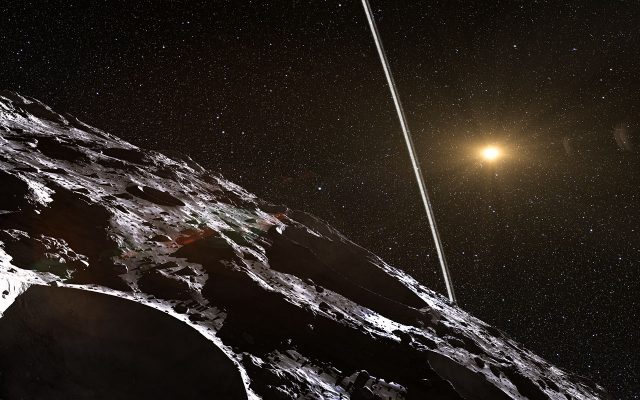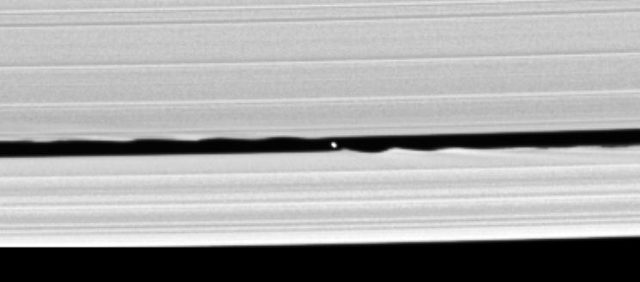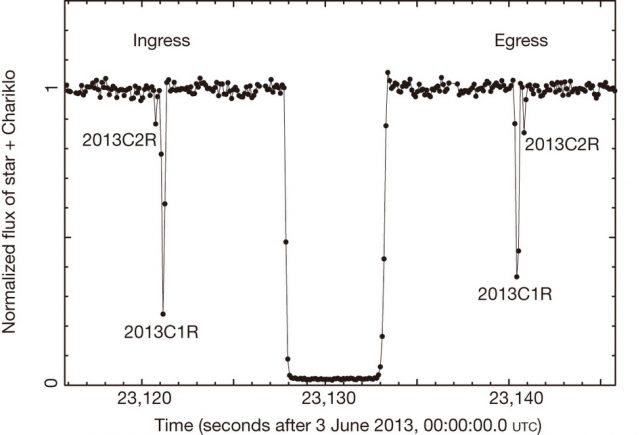Ringed worlds

Galileo Galilei was the first person to see rings around a planet. He was unable to understand the image in the eyepiece of his simple, though revolutionary, telescope. Was it a triple planet? Were it handles? Much to his surprise, the unfathomable shape of Saturn changed as years went by. It took some decades to Christian Huygens to realize that these were rings floating around the planet and almost two centuries to James Clerk Maxwell to conclude that such rings should be formed by unconnected particles. Rings were found also around all the other three giant planets (Jupiter, Uranus and Neptune) during the last half of the second century. And now, serendipity brings yet another case, around a dark, distant body called Chariklo: one of the Centaurus riding the outer Solar System 1.
Rings are related to a number of interesting astrophysical phenomena, from galaxies to planetary formation, since they all share some common processes. This makes the study of planetary rings a superb laboratory for testing the physics of the n-body gravitational interaction. The first aspect we should revise before entering into details is the Roche limit, which is the distance a given object can get to a massive body before being disrupted by tidal forces. All known rings, with the exception of the most tenuous and distant Saturn’s rings, happen inside the Roche limit for water bodies. Since the Roche limit obviously depends on density, rocky satellites could get closer to the planet before they break. The dynamics of the rings is also determined by the position of synchronous orbits and gravitational resonances which deserve much space than what we have here. As suggested initially by Goldreich and Tremaine for Uranus rings 2, the presence of so-called “shepherd satellites” also plays a substantial role in spreading or controlling the outward and inward difussion of the ringlets around the planet. All these ideas have been extensively tested thanks to the astonishing observations of Saturn’s rings by the Cassini spacecraft orbiting Saturn, as summarized for example by Colwell and others in their review of the initial phase of the mission 3.

But even though we can learn a lot from planetary rings it must be noted that most of them are newcomers. Jupiter’s rings, for example, were discovered in 1979 4, only when Voyager 1 flew around. It was only a few hours before the closest encounter with the planet that it was possible to see its effect on star trails during a long exposure. In fact, it was a fortuitous discovery as long as it was expected to find rings with the same scale as those in Saturn and so only their outer region was imaged. The young and thicker Uranus’ rings were detected a couple of years before (1977), in spite of previous claims of discovery in the XVIII century. Neptune followed five years later than Jupiter (1984), when astronomers at La Silla anticipated what was later observed during Voyager 2 flyby.
Now, 30 years after the last ring discovery we are again witnessing the miracle. Chariklo is what we call a Centaur, a small object whose orbit is located between Jupiter and Neptune. It was expected that the occultation of a 12 magnitude star was going to be visible from countries in South America. This kind of event provides information on the size and shape of the object, as long as the shadow cast by Chariklo would extend to one part or another. For this reason, it is usual to try to observe occultations from place where, in principle, it will be impossible to see any change in the star brightness, just in case it happens and reveals an unexpected characteristic for the problem body. And this is exactly what happened with Chariklo: two symetrical eclipses happened at the sizes of the object, far from the central line, revealing the presence of the rings.

Even though the rings look like a very plausible explanation to what was seen, a sanity check demanded to test other options. It is very unlikely that satellites can be located in such a peculiar configuration and only some 5% of Centaurs and trans-Neptunian objects are known to have satellites. None have been identified for Chariklo so far. Can it be cometary jets? Again, the optical depth estimated from extinction is remarkably symmetrical at both sizes, not very compatible with this idea.
There is further evidence supporting rings around Chariklo. It had been previously reported that Chariklo was getting dimmer, in good agreement with the ring opening angle fitted from current observations. Moreover, there had been changes in the water-ice absorption in the previous 10 years, again compatible with observations if water ice is present in the rings. So, all in all, rings are the best available explanation.
Taking a look at the big picture, all four giant planets in our Solar System do have rings, although the thick and extended Saturnian rings are exceptional by all means. Among the rest of the bodies, we have only detected them around a quite small one. However, with respect to Chariklo rings it seems that they could be former further out in the Solar System and be able to survive a migration towards the relatively closer place it now lives in.
References
- Braga-Ribas F., Sicardy B., Ortiz J.L., Snodgrass C., Roques F., Vieira-Martins R., Camargo J.I.B., Assafin M., Duffard R. & Jehin E. & (2014). A ring system detected around the Centaur (10199) Chariklo., Nature, PMID: 24670644 ↩
- P. Goldreich and S. Tremaine (1979). Towards a theory for Uranian rings. Nature 277, 97-99. doi: 10.1038/277097a0 ↩
- J.E. Colwell et al. (2009). The structure of Saturn’s ring in Saturn from Cassini-Huygens (pp. 375-412), Eds. M.K. Dougherty, L.W. Esposito, S.M. Krimigis. Springer, New York. d.o.i.: 10.1007/978-1-4020-9217-6 ↩
- B.A. Smith et al. (1979). The Jupiter system through the eyes of Voyager 1. Science 204, 951-972. doi: 10.1126/science.204.4396.951 ↩
4 comments
[…] donde menos se los esperaba: alrededor de un cuerpo distante y oscuro llamado Cheriklo. Más en Ringed Worlds por Santiago Pérez […]
[…] Galileo Galilei lehena izan zen eraztunak ikusten planeta baten inguruan. Aldiz, ez zen izan gai haren teleskopio sinple eta iraultzailearen bidez ikusten zuen irudia ulertzeko. Hamarkadak behar izan ziren Christian Huygens konturatu arte planetaren inguruan flotatzen zeudenak eraztunak zirela […]
[…] [Leer la entrada completa en Mapping Ignorance] […]
[…] behatokitik Chariklo zentauroaren[2] trantsitu bat behatzen ari zirela, egiaztatu ahal izan zuten bi eraztunez osatutako sistema bat daukala zentauro horrek (ikus 4. irudia). Eraztun hauek oso dentsoak zirela ondorioztatzeaz gain, gutxienez […]